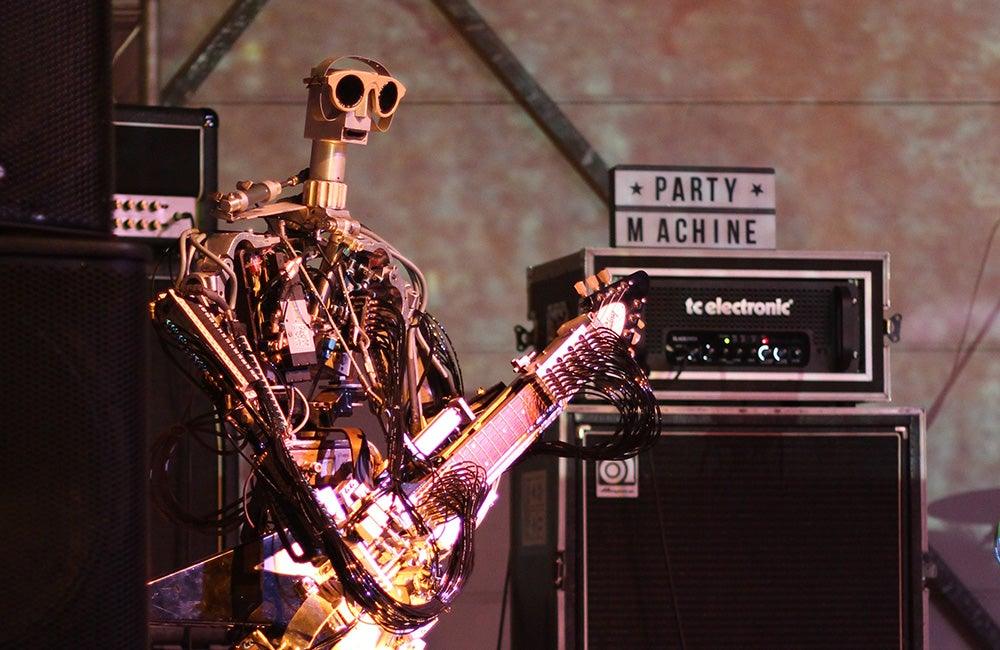First published: Spring 2019
A successful rock band made up entirely of robots, created by Berlin-based artists and engineers
Travelling west from Berlin’s bustling central area of Mitte, across the river Havel, takes me to Spandau, a borough known for its waterways and charming old town. The directions I’ve been given lead me down a sleepy side street to a large, white architectural box, the exterior of which gives away few secrets. Inside, an unexpectedly large space is revealed, packed with offices, hi-tech machines, work benches, spare parts and flight cases. It’s not exactly an MTV crib, but it is the home of Compressorhead – the band I have come to meet, just before their lead singer, “Mega Wattson”, heads off to Rotterdam’s Tec Art Festival for Creative Technology. The band – Mega Wattson included – is comprised entirely of robots.

Compressorhead playing a solo show in Trondheim, Norway in 2017, left to right: Fingers, Frank Barnes (background), Wattson, Hellgå Tarr, Stickboy, photo: NVB
Compressorhead came to international attention in 2013 when their line-up was “Stickboy” on drums, “Schmidi” on hi-hat, “Bones” on bass and “Fingers” on guitar. A simple smartphone video featuring their cover of Motörhead’s Ace of Spades went viral. Bands and their marketeers strive for such an online reaction – this spontaneous, uncalculated instance points to something intrinsic in the robot band, something that struck a chord with people. Judging from Compressorhead’s enduring popularity, it still does.
The band is the project of Berlin-based artists Frank Barnes and Markus Kolb, and electronics engineer Stock Plum, with some help from another, Sydney-based, engineer called Miles van Dorssen. It has taken the best part of a decade to get to the band’s current six-member line-up. Since 2013’s Ace of Spades video, a second guitarist, “Hellgå Tarr”, and singer, Mega Wattson, have been added, creating a fuller and more complex sound.
Compressorhead’s origins date back to 2007 with Barnes’s creation of Stickboy, the four-armed and two-legged drummer, who in the early days performed flanked by two robot pole dancers. Stickboy was the creator’s tenth robot. Previously, there had been the boxer “JP” (“Johnny Pneumatic”), a skeletal head, arms and torso who tried his hand at drumming, painting, dancing and smoking before realising that his talents lay in the bouncer profession (positioned by the door in bars and clubs, he would punch people as they entered). Other early creations included: “The Headless Batsman”, a baseball bat swinging robot; the “Topless Dancer”, a pair of dancing legs; and “Tutti Frutti”, a sometimes-incontinent, swinging-trapeze monkey. This talent for mixing robotics with showmanship, playfulness and humour brought his work to the attention of Swiss artist and Alien-designer HR Giger, and led to them “having tea and playing with robots” in Giger’s front room.
Barnes is entirely self-taught with no formal education in the field of mechanics or engineering. He moved to Berlin in the early 1990s as part of a punk band. It was a time of great change and chaos in the city, as the infrastructure of the former East had to mesh with that of West Germany and its higher standards. Suddenly, the equipment in hospitals, offices and factories was rendered obsolete and in need of updating; and vehicles, now subject to more rigorous scrutiny, were being declared unroadworthy and abandoned on roadsides. Barnes found himself in a city with a punky, DIY attitude, where a wealth of free material could be found to foster the experimental beginnings of his practice. He also found inspiration in the raves and parties of music and arts collectives, such as the Mutoid Waste Company and Spiral Tribe.
This is an article extract; read the full article in Raw Vision #101




